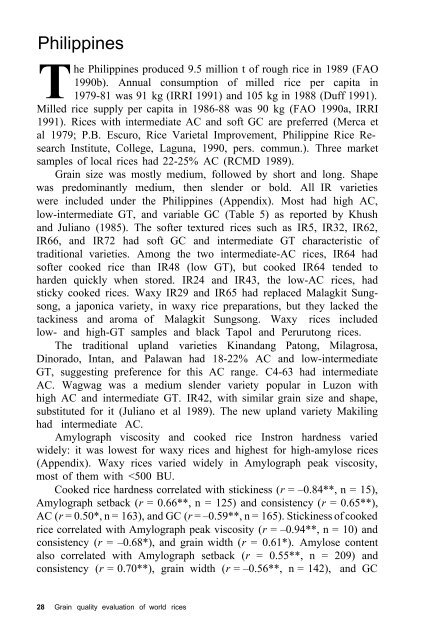Juliano et al. - 1993 - Grain Quality Evaluation of World Rices
Juliano et al. - 1993 - Grain Quality Evaluation of World Rices
Juliano et al. - 1993 - Grain Quality Evaluation of World Rices
Create successful ePaper yourself
Turn your PDF publications into a flip-book with our unique Google optimized e-Paper software.
Philippines<br />
T<br />
he<br />
Philippines produced 9.5 million t <strong>of</strong> rough rice in 1989 (FAO<br />
1990b). Annu<strong>al</strong> consumption <strong>of</strong> milled rice per capita in<br />
1979-81 was 91 kg (IRRI 1991) and 105 kg in 1988 (Duff 1991).<br />
Milled rice supply per capita in 1986-88 was 90 kg (FAO 1990a, IRRI<br />
1991). <strong>Rices</strong> with intermediate AC and s<strong>of</strong>t GC are preferred (Merca <strong>et</strong><br />
<strong>al</strong> 1979; P.B. Escuro, Rice Vari<strong>et</strong><strong>al</strong> Improvement, Philippine Rice Research<br />
Institute, College, Laguna, 1990, pers. commun.). Three mark<strong>et</strong><br />
samples <strong>of</strong> loc<strong>al</strong> rices had 22-25% AC (RCMD 1989).<br />
<strong>Grain</strong> size was mostly medium, followed by short and long. Shape<br />
was predominantly medium, then slender or bold. All IR vari<strong>et</strong>ies<br />
were included under the Philippines (Appendix). Most had high AC,<br />
low-intermediate GT, and variable GC (Table 5) as reported by Khush<br />
and <strong>Juliano</strong> (1985). The s<strong>of</strong>ter textured rices such as IR5, IR32, IR62,<br />
IR66, and IR72 had s<strong>of</strong>t GC and intermediate GT characteristic <strong>of</strong><br />
tradition<strong>al</strong> vari<strong>et</strong>ies. Among the two intermediate-AC rices, IR64 had<br />
s<strong>of</strong>ter cooked rice than IR48 (low GT), but cooked IR64 tended to<br />
harden quickly when stored. IR24 and IR43, the low-AC rices, had<br />
sticky cooked rices. Waxy IR29 and IR65 had replaced M<strong>al</strong>agkit Sungsong,<br />
a japonica vari<strong>et</strong>y, in waxy rice preparations, but they lacked the<br />
tackiness and aroma <strong>of</strong> M<strong>al</strong>agkit Sungsong. Waxy rices included<br />
low- and high-GT samples and black Tapol and Perurutong rices.<br />
The tradition<strong>al</strong> upland vari<strong>et</strong>ies Kinandang Patong, Milagrosa,<br />
Dinorado, Intan, and P<strong>al</strong>awan had 18-22% AC and low-intermediate<br />
GT, suggesting preference for this AC range. C4-63 had intermediate<br />
AC. Wagwag was a medium slender vari<strong>et</strong>y popular in Luzon with<br />
high AC and intermediate GT. IR42, with similar grain size and shape,<br />
substituted for it (<strong>Juliano</strong> <strong>et</strong> <strong>al</strong> 1989). The new upland vari<strong>et</strong>y Makiling<br />
had intermediate AC.<br />
Amylograph viscosity and cooked rice Instron hardness varied<br />
widely: it was lowest for waxy rices and highest for high-amylose rices<br />
(Appendix). Waxy rices varied widely in Amylograph peak viscosity,<br />
most <strong>of</strong> them with

















